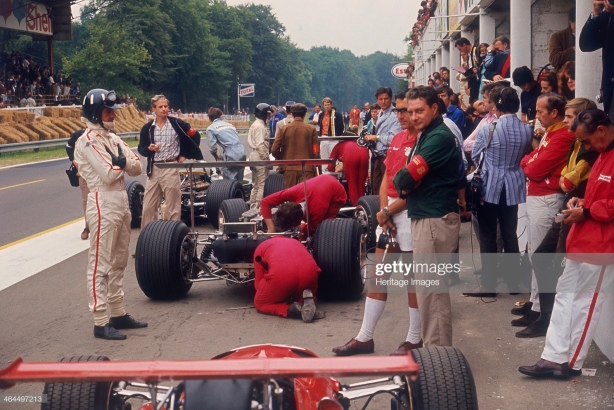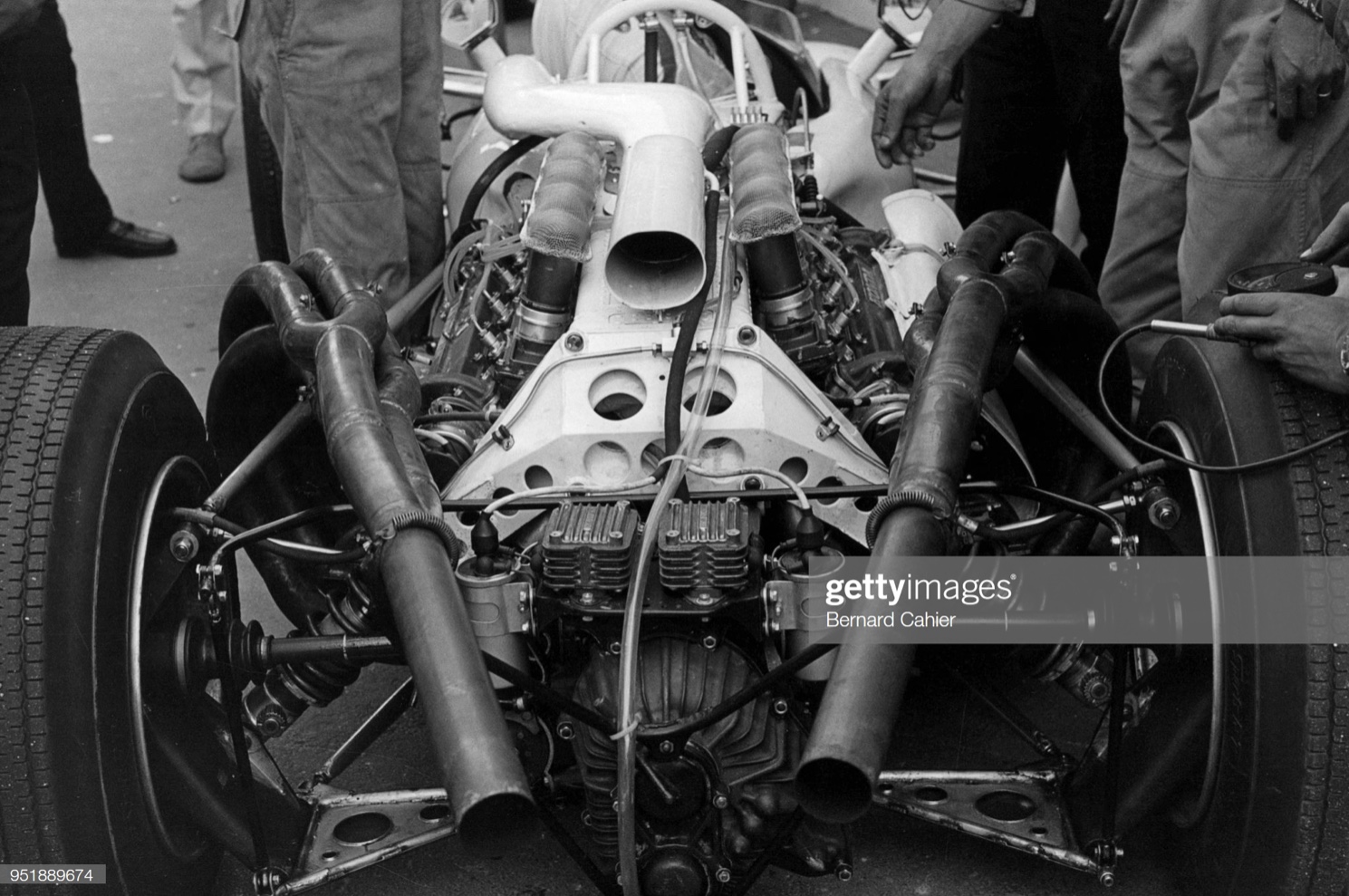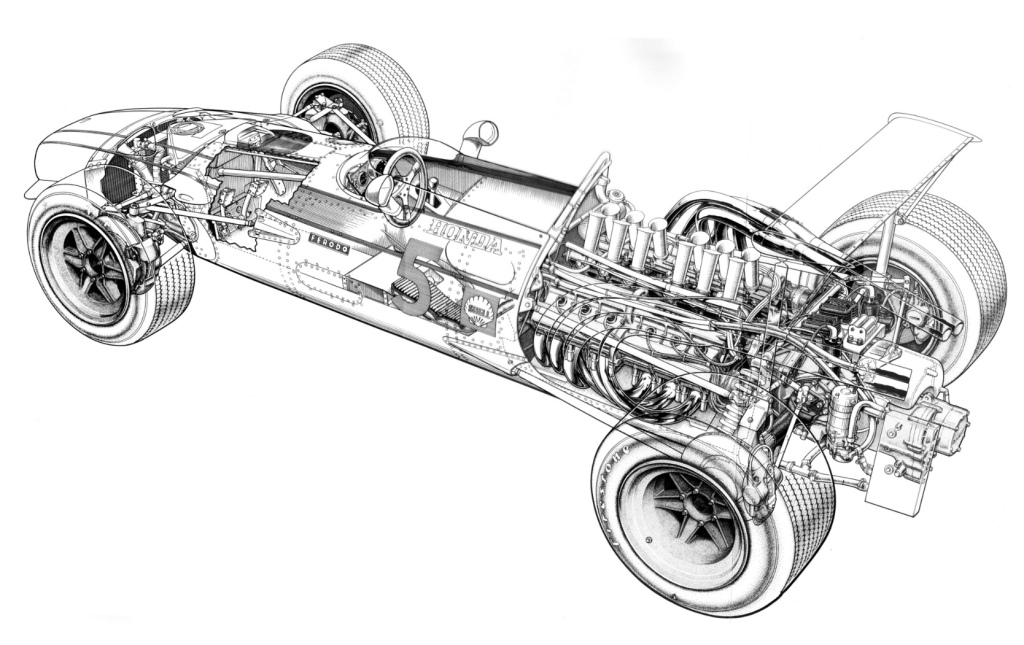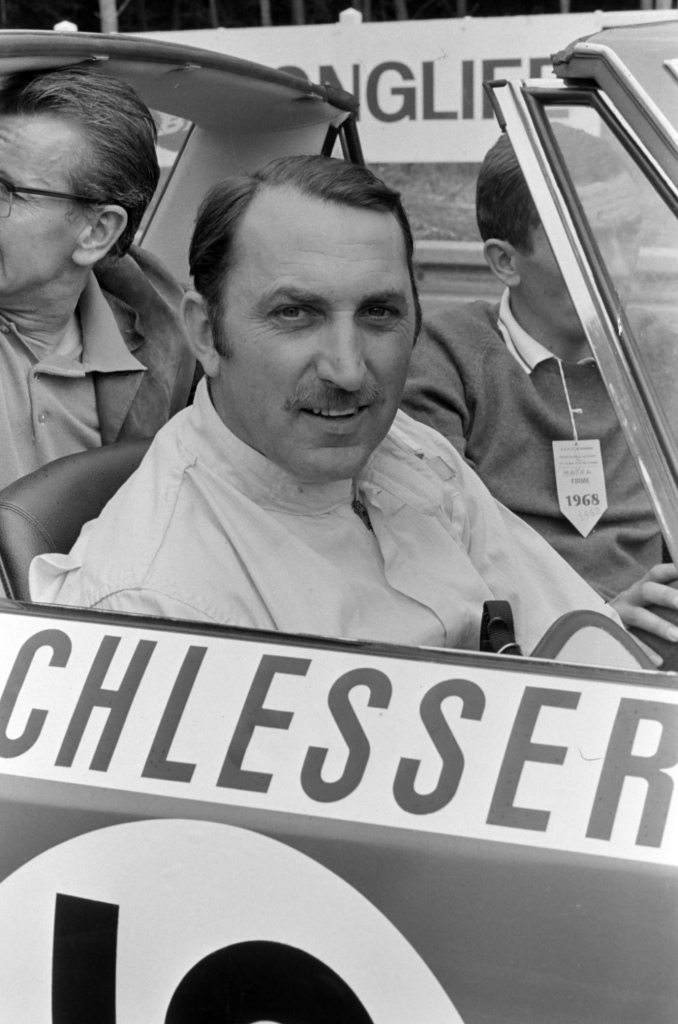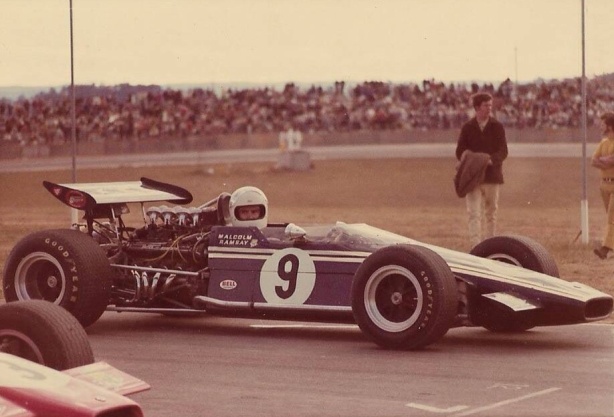
(P Greenfield)
Malcolm Ramsay awaits the start of the ‘Diamond Trophy’ Gold Star race at Oran Park on 28 June 1970…
His car is an Elfin 600C Repco ‘730’ 2.5 litre V8, alongside him you can just see the nose of the cars constructor, Garrie Cooper’s Elfin 600D ‘830’ V8- only three of these Repco V8 engined Elfins were built, John McCormack’s Elfin 600C was the other, and all are ‘Australian Motor Racing Royalty’ to me- about as good as it gets!
The Oran Park round was the third of the 1970 series, a championship which was wide open- reigning champion Kevin Bartlett had finished third in the first Symmons ‘Tasmanian Road Racing Championship’ round behind John Harvey’s old-faithful Brabham BT23E Repco and Leo Geoghegan’s equally venerable Lotus 39 Repco.

Bob Jane, John Harvey, a young Pat Purcell, ? and John Sawyer, side on during the 1970 Symmons round- car wing is BT23E (oldracephotos.com.au)

Symmons Plains 1970- changing of the guard- last race for Harvey’s Brabham BT23E Repco, Geoghegan’s white Lotus 39 Repco and almost KB’s last race in the Mildren Yellow Submarine Waggott. Max Stewart in the Mildren Waggott on row 2 (H Ellis)

Leo Geoghegan and Garrie Cooper at Symmons in 1970 (oldracephotos)
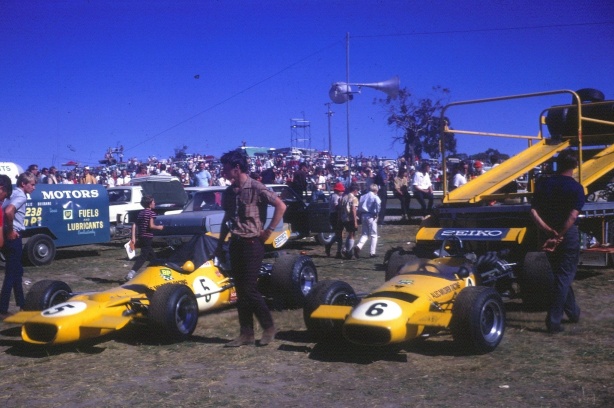
The Mildren Duo- The Sub, Mildren Waggott with Glynn Scott’s blue trailer alongside
At Lakeside for the ‘Governor’s Trophy’ in early June, Max Stewart won from Harvey’s new car, the ‘Jane Repco V8′ built on Bob Britton’s Brabham BT23 jig. It was a modified car with suspension geometry suited to the latest generation of cars and other tweaks. Bartlett DNF’d with ignition problems- and Leo Geoghegan made the championship debut of his Lotus 59B Waggott 2 litre ’59-FB-14’, at long last (or sadly depending upon how you view that wonderful Lotus 39) Leo had a modern car, that 39 had served him so well but had not delivered the Gold Star it was surely capable of- with Repco reliability in 1967 or 1968.

Lakeside, Governor’s Trophy 7 June 1970. Pole-sitter and winner Max Stewart in the Mildren Waggott with Kevin Bartlett in the Mildren ‘Yellow Submarine’ Waggott alongside (G Ruckert)
After Lakeside KB jumped on a plane to the ‘States to chance his arm over there in Indy racing- he raced on and off in the US from 1970 to 1973- we must get him to tell us that story.
Garrie Cooper, perhaps the other driver capable of winning the Gold Star that year also had a poor start to the season with his new Repco 830 Series V8 powered Elfin 600D ‘7012’. At Symmons he retired with a flat battery having failed to set a time in practice and at Lakeside he was ninth from Q5 with a misfire for the races duration.
Malcolm Ramsay was a title contender too- if the Repco planets could be aligned, mounted as he was in Cooper’s first Repco engined 600- the 600C ‘6908’ raced by Garrie in Asia and then sold before returning to Oz in late 1969.

GC Cooper, Elfin 600D Repco ‘830’, Oran Park June 1970- oh to have seen an ace in this chassis (oldracephotos)
1970 was an odd year in terms of Gold Star eligibility…
The Confederation of Australian Motor Sport made the following naff decisions during 1969 in an attempt to keep the peace with all interested parties- an impossible challenge of course and provide a formula, or formulae to suit the needs of Australian single-seater racing into the future. A summary of the rules for the next couple of years goes a bit like this;
1970 Tasman Series- Tasman 2.5, F5000 and 2 litre cars and under
1970 Gold Star- Tasman 2.5 and 2 litre cars and under
1971 Tasman- Tasman 2.5, F5000 and 2 litre cars and under
1971 Gold Star- F5000 and 2 litre cars and under
1972 Tasman- ditto as per ’71 Gold Star
1972 Gold Star- F5000 and ANF2 (to make up the numbers)
The impact of the above in 1970 was that those fellas who invested in F5000 could not race their cars in Australia- in particular Frank Matich and Niel Allen, both round winners during the 1970 Tasman could not race their McLarens in Gold Star events- a bummer for them and their fans but a bonus for the rest of the elite grid- Bartlett, Matich and Allen were out of the equation in 1970.
The machinations of the change from the Tasman 2.5 to F5000 category are ventilated at length in this article;
Repco Holden F5000 V8…
Wearing my Repco bias on my sleeve- 1970 was it, the last opportunity for the Maidstone concern to win either a Tasman or Gold Star 2.5 litre title for their beautiful little V8’s!

Max, second on the grid before the off, Mildren Waggott TC4V 2 litre. A jewel of a car and uber successful chassis (P Greenfield)
And so the title protagonists headed in the direction of Narellan on Sydney’s then western outskirts for the Oran Park round…
John Harvey put his stamp on practice with a 43 seconds dead lap in the Jane Repco with Max Stewart’s Mildren Waggott two-tenths adrift on a circuit Max knew like the back of his hand.
Its interesting that Max/Alec chose to keep racing the spaceframe car rather than the ‘Sub, a monocoque (after KB went away) but I guess Max wore that car like a glove- an extension of his body and he was never more than a bees-dick away from KB in terms of pace, so why not sell the Sub and keep the little Mildren nee Rennmax Waggott?

John Harvey ahead of one of the Elfin 600’s. Jane nee Rennmax Repco V8 – 830 Series V8. Bob Jane obtained the 830 V8’s used by Jack Brabham in the 1969 Brabham BT31- good works motors (L Hemer)
And as most of you know Mildren commissioned an F5000 car which Bartlett raced in the 1970 AGP and throughout the 1971 Tasman Series before the team was, very sadly, disbanded. But lets not get distracted from Oran Park.
Geoghegan did the same time as Max- he had clearly got to grips with the Lotus chassis and Waggott motors quickly having pedalled Repco V8’s since mid-1967. His Repco 830 would have had a smidge over 300 bhp with the Waggott at that stage of its development circa 265 bhp- albeit the 59B would have been a bit lighter overall than the 39.

Leo raced sans nose wings. Lotus 59B Waggott TC4V- yes please. OP June 1970 (oldracephotos)
Bob Muir demonstrated his growing pace with a 43.6 in his Rennmax BN2/3, at this meeting 2.5 Coventry Climax FPF powered- my guess is this was the best Gold Star FPF performance for a couple of years, by then these motors were no spring-‘chookins at all having taken two World Championships on the trot for Cooper/Jack Brabham in 1959 and 1960.
Bob bought a Waggott TC4V 2 litre engine which he popped into this chassis (in specification it is a BN3 but Bob referred to it as a BN2 ‘in period’) before the following ‘Sam Hordern Trophy’ round at Warwick Farm in early September and then later in the year bought the Mildren Yellow Sub off Alec and put the Waggott into that chassis- and somewhat famously rated his Rennmax BN2/3 the better car of the two. (same chassis as the Mildren Waggott).
Garrie Cooper and Malcolm Ramsay were fifth and sixth with a 44.6 and 45 seconds dead respectively, perhaps more could have been expected of the two V8’s but the dudes in front of them were all ‘locals’- if you can refer to an Orange resident as ‘local’ in Max’s case and Melbourne local for Harves! Harvey did plenty of laps at Oran Park before he emigrated to Mexico (Melbourne) when he started driving for Bob Jane .
John McCormack took the next step in his career when he replaced the ex-Jack Brabham 1962 AGP Caversham Brabham BT4 Climax FPF with an Elfin 600C in time for the 1970 Gold Star.
Fitting it with the FPF from the Brabham was sub-optimal but he was in the process of putting together a lease deal on a 740 Series Repco V8 with Malcolm Preston which would take him a further step along the path towards national championships in the years to come.

One day of The Year- that you can race your F5000 that is. Frank Matich on the way to 1970 AGP victory in his McLaren M10B Repco Holden (N Foote)
Preston and Mac developed a lifelong friendship during the Repco Holden F5000 years- Preston was the General Manager of REDCO, the Repco Engine Development Company which assumed the assets (most of ’em) of Repco Brabham Engines Pty. Ltd. and designed, built and maintained the Repco-Holden motors.
That Repco 740 engine was nestled in the spaceframe of Mac’s 600 ‘7011’ by the Hordern Trophy meeting, so he used it at WF, Sandown, Mallala (pole) the AGP at the ‘Farm in November as well as the Warwick Farm Tasman meeting in February 1971.
In 1970 the Australian Grand Prix was a stand alone meeting- not part of the Gold Star or Tasman Series and allowed Tasman 2.5, 2 litres and under- and F5000’s!
Warwick Farm Meister Frank Matich won the race from a strong field in his McLaren M10B Repco Holden- it was the first ‘notch in the belt’ for another world class race engine from the Repco boys, the design of which was led by Phil Irving- he of Vincent and Repco Brabham Engines ‘620 Series’ fame with the assistance of Brian Heard, also ex-RBE.

Queenslander Glynn Scott in his brand spankers Elfin 600B Waggott TC4V, DNF (L Hemer)
Meanwhile, back at Oran Park in June…
Glynn Scott was next up, seventh in a brand new Elfin 600B Waggott 2 litre. Glynn was sure to be quick in this car over the next season or two but his time in it was way too short, only a month later he was killed in an awful accident at Lakeside when he and his friend Ivan Tighe collided, Ivan also Elfin 600 mounted.
Waggott engined Elfin 600’s are rare beasts- this (destroyed) chassis ‘7016’, Gary Campbell’s ‘7122’ (the chassis, then powered by a Lotus-Ford twin-cam in which Larry Perkins won the 1971 ANF2 Championship) and Ramsay’s ‘6908’ were so equipped.
The Goodwins, unrelated were next, Len in the ex-Piers Courage/Niel Allen McLaren M4A ‘M4A/2’ Ford Cosworth FVA, the Pat Burke owned car soon to become an important stepping stone in the career of Warwick Brown who raced it in 1971 before stepping into another ex-Allen McLaren, M10B F5000, for 1972- fame if not fortune followed.

Ken Goodwin’s Rennmax BN3 Ford in the OP paddock June 1970 (K Hyndman)
Ken Goodwin who had come through Formula Vee raced a beautifully self-prepared Rennmax BN3 Lotus-Ford t/c ANF2- its amazing how many guys did well in these beautifully forgiving motor-cars. Ron Tauranac got the Brabham BT23 design spot on and Bob Britton didn’t bugger things up in his translation of same!
The thirteen car grid was rounded out by the ANF2 1.6 cars of Jack Bono, Brabham BT2 Ford t/c, Ian Fergusson, Bowin P3 Ford t/c and Noel Potts Elfin 600 Alfa Romeo 1.5.
Come race-day there were only twelve starters, unfortunately Muir’s Coventry Climax engine had ‘oil leaks’ which could not be remedied.

Stewart’s Mildren sorted before the off- Glenn Abbey and Alec Mildren look on as Derek Kneller at front and Ian Gordon set final tyre pressures. Waggott 2 litre TC4V engine and FT200 Hewland ‘box (K Hyndman)
Gold Star fields in terms of numbers were always tough, other than in the Formula Pacific and Formula Holden ‘peaks during the eighties/nineties- in 1970 the number of starters were; Symmons 11, Lakeside 17, Oran Park 12, Warwick Farm 12, Sandown 18 and Mallala 12- the AGP, not a Gold Star round had 19 starters with F5000 making the difference in the main.
The field was interesting too- all of the top-liners were racing cars with spaceframe chassis, four had Repco 730 or 830 ‘crossflow’ V8’s, three modern as tomorrow Waggott 2 litres started, with one Ford Cosworth FVA, an ‘old school’ Coventry Climax FPF in the back of McCormack’s Elfin 600 and a smattering of Lotus-Ford twin-cam ANF2’s plus Pott’s 1.5 litre twin-cam, long stroke Alfa Romeo.

Look mum, one hand! Stewart shows perfect control and a gaggle of car down OP’s Main Straight (L Hemer)
The 82 lap race was won by Max Stewart by 17 seconds from the similarly engined Lotus 59 of Geoghegan, then the ‘Elfin-GT Harrison Racing’ 600 Repco’s of Garrie Cooper and Malcolm Ramsay.
McCormack was two laps back in his 600 FPF from John Harvey a couple of laps back with problems.
Than came Ian Fergusson’s monocoque Bowin P3 Ford, Noel Potts Elfin 600 Alfa and Glynn Scott with only 50 laps in his 600 Waggott.
As Max Stewart left Oran Park for home in Orange on the Sunday night little did he know the high point of his 1970 Gold Star season had been reached, he took no points at either of the following Warwick Farm (injector problem) or Sandown (bearing) rounds won by Leo Geoghegan and John Harvey respectively.

John Harvey in the Jane Repco V8 in Warwick Farm’s Esses during practice for the Septmeber Gold Star round won by Geoghegan from Cooper and Muir. Harves Q4 and DNF fuel pump (L Hemer)
In fact the difference between Leo and his pursuers that season was a blend of speed and consistency- lessons from his Repco years!
He won two of the six rounds but scored in all but one. Stewart and Harvey both won two rounds as well but scored points in four rounds apiece. Harves went mighty close though, he recalled recently ‘…at the last round of the Gold Star at Mallala I was so far in front of Leo Geoghegan and Max Stewart I thought I had the race and the series in the bag. However, not to be, the left front suspension broke and took me off the road.’
In terms of qualifying performances, often an indicator of outright speed, Harvey took pole on three occasions with Stewart, Geoghegan and McCormack, the latter at Mallala using his Repco V8, to good effect once.
Geoghegan won the championship with 33 points from Stewart 27, Harvey 25, Cooper 16 and Ramsay 9.

Leo’s 59B before the off with Bob Holden’s Escort Twin-Cam sharing the Castrol tent. OP June 1970, car still in Oz (K Hyndman)
Leo Geoghegan- Lotus 59B…
Leo Geoghegan’s Lotus 59B Waggott…
Max Stewart- Mildren Waggott…
Singapore Sling…
Bob Muir- Rennmax BN3 Waggott…
Rennmax BN2 Waggott…
Garrie Cooper- Elfin 600D Repco…
Garrie Cooper, Elfin 600D Repco V8
1970 Gold Star Season…
https://www.oldracingcars.com/australia/1970/
Credits…
Peter Greenfield, Harold Ellis, Lynton Hemer, oldracingcars.com.au, Nigel Foote, Ken Hyndman, oldracephotos.com.au, John Harvey, Graham Ruckert
Tailpiece: Harves and Hottie, Maxxie and ‘Yoko Ono’…

(L Hemer)
Finito…































